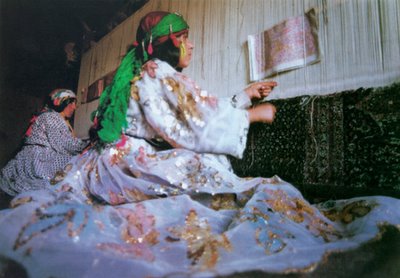 Carpet maker in Makû, East Kurdistan
Carpet maker in Makû, East KurdistanBerikên Kurdî - Kurdish Rugs/Carpets
In the words of William Eagleton:
For most of us a rug type exists only after it has reached international markets and has been seen and classified by collectors and scholars. Until then rugs and other weavings can be present in considerable numbers in their natural habitats without attracting the attention of the outside world. This was the case with many Anatolian, Iranian, and Iraqi kilims, bags, and trappings 20 years ago; however, it seemed unlikely that by 1988 any major rug type was still awaiting discovery. Nevertheless, such a weaving has recently emerged from the Kurdish heartland of Eastern Turkey.
A Kurdish woman weaving...
For the Kurds, rugs have a special place. Kurds respect their rugs and value them. As it takes a lot hard work and time to make one of these beautiful master pieces. The traditional Kurdish colors include different shades of red, green, yellow and traditionally with shades of black/brown/white as backgrounds.
Traditionally, in the Middle East, making rugs is a job preserved for women, but this varies from region to region in Kurdistan. Where I come from, Ûrmî, women will usualy have many projects at one time. Making a rug, knitting and on the side the chores of the house. This is done so that they don't tire from doing the same thing all day. Going to knitting when they are tired of weaving and from weaving to sowing clothes or making some bread ("Nan" in Kurdish). Either way, they spend a lot of their time weaving.
It is estimated that in general a weaver work 900 + hours to produce a 2x1.5 meters rug. It should then not come as a surprise that Kurds traditionally never step on these rugs with their shoes, but take them of before. After all , somebody has worked hard to create this beauty!
Some beautiful Kurdish rugs:
This one is dated ca. 1955.
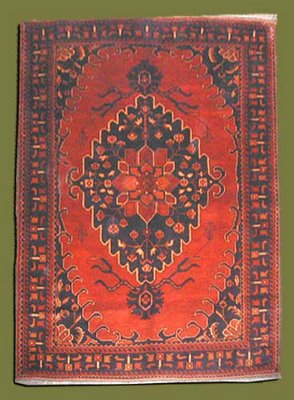 This beautiful rug (my favorite) is dated ca. 1965.
This beautiful rug (my favorite) is dated ca. 1965.
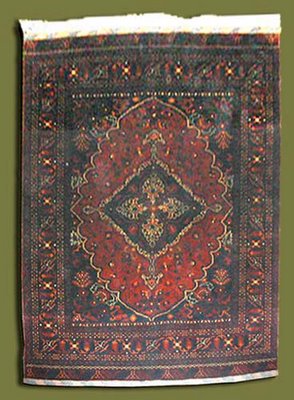 This one is dated ca. 1965.
This one is dated ca. 1965. 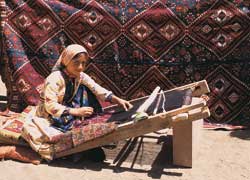
About Zagheh Rugs
The Zagheh are a Kurdish tribe living in Kurdistan. These tribes market their rugs in the surrounding area of Hamadan. The bright and lively colors and the creative geometric shapes are typical of a Zagheh Kurdish rug design.
 History & Construction
History & ConstructionKurdish carpets are woven throughout western Iran, in and around the rugged mountains of Kurdistan. The resilient Kurds descend from the ancient nomads that roamed the area thousands of years ago. They live a semi-nomadic life, either in villages or in tribes away from the cities where they can still practise their traditions and live as their ancestors did. Some Kurdish tribes include the Herki, Senjabi, Gurani, Jaffid, and Kalhors. Major rug-producing centers include Senneh, Bidjar, and the district of Khamseh.
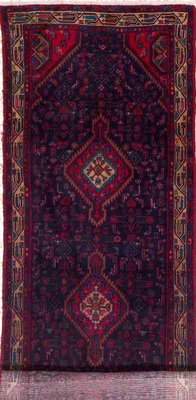
Other Kurdish villages and districts that produce rugs are Borchelu, Goltogh, Khoi, Koliai, Lylyan, Mousel, Nanadj, Songhore, Touserkan, and Zagheh. There are many grades of hand-made rugs produced in this vast province, and almost every color can be seen in these rugs. All have a pile of wool, and the foundations are of cotton, or more rarely, wool or goat hair. The weaving quality in Kurdish rugs varies from loose to dense knotting and the Persian asymmetrical knot is used more frequently than the Turkish symmetrical knot. 

The colors are mainly from natural dyes, and bright lively colors are used to bring life to their simple homes. The Kurds are a very peaceful, gentle people who prefer their simple nomadic lives to the complexities and frustrations of the modern world. Many other major rug-producing centers of Iran, such as Hamadan, Lorestan, or even Arak, show traces of Kurdish influence.


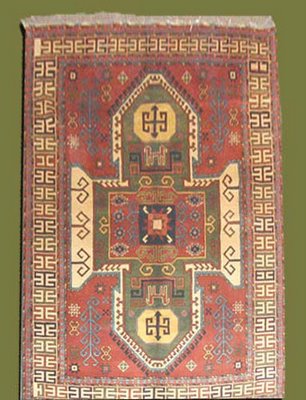

Excellent, love it! » »
ReplyDelete
ReplyDeletepic sex teen
cute teen
site teen
angel teen
free picture sex teen
teenager
pink teen
teen tgp
japanese teen
orgasm teen
erotic most teen
amateur kingdom teen
muscle teen
strip teen
strip teen
ReplyDeletex-lumberjack-com.blogspot.com/>lumberjack
do you have some information on the town of goltogh? if yes, kindly contact me!
ReplyDeleteSome amazingly beautiful oriental rugs there! Thanks for sharing.
ReplyDelete